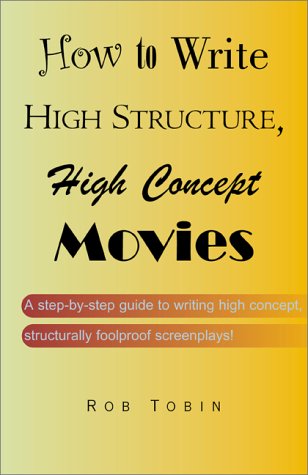
Book Review: ‘How to Write High Structure, High Concept Movies’
Written by Peter Bohush | Posted by: Anonymous
I used to maintain that a book about writing made as much sense as a car about driving. With Rob Tobin’s book "How To Write High Structure, High Concept Movies," I will make an exception because this is an exceptional book.
The book is exactly what the title states: a step-by-step manual on how to write structurally sound, high-concept, "formulaic" screenplays.
Rob Tobin has read more than 5,000 scripts as a script reader, development exec, and script doctor for some big names in Hollywood: Freddie Fields ("Glory"), Stephen Cannell ("The A-Team"), Joe Singer ("Dr. Doolittle"), and Bill Carraro ("Frequency"). He is also former writing coach and VP of development for The Writers’ Boot Camp.
As his basic premise, Tobin contends, "…bad films aren’t formulaic — and that’s the problem!" If more screenplays adhered to the basics covered in this book, they would spot the problems and be able to correct them before turning the script into an awful film.
Tobin does concede that some really terrible scripts become highly successful movies. A case in point is "Titanic," which set box office records and earned 11 Oscars — though its screenplay wasn’t even nominated. Still, the odds are that bad scripts will become bad movies, if they even get made at all. To improve your odds of writing a good script that might become a good movie, follow Tobin’s guidelines.
Tobin doesn’t contradict the how-to’s of other writing coaches such as Syd Fields. The three-act structure is followed. But Tobin breaks the acts down further into structural beats tied to the actions of the characters in their quests to overcome their flaws in the face of some life-changing event. He helps writers identify the script’s objective and subjective storylines. The objective storyline is the backdrop against which the hero’s story plays — the Japanese invasion and subsequent war in Pearl Harbor. The subjective storyline is the hero’s story — battling the opponent to overcome his/her character flaw.
Seven Script Elements
According to Tobin’s book, a well-written screenplay consists of seven basic elements:
- A hero — the person through whose eyes we see the story unfold, set against a larger background.
- The hero’s character flaw –a weakness or defense mechanism that hinders the hero in such a way as to render him/her incomplete.
- Enabling circumstances — the surroundings the hero is in at the beginning of the story, which allow the hero to maintain his/her character flaw.
- An opponent — someone who opposes the hero in getting or doing what he/she wants. Not always a villain. For example, in a romantic comedy, the opponent could be the man or woman whom the hero seeks romance with. The opponent is the person who instigates the life-changing event.
- The hero’s ally — the person who spends the most onscreen time with the hero and who helps the hero overcome his/her character flaw.
- The life-changing event, a challenge, threat or opportunity occurring at the end of Act I, usually instigated by the opponent, which forces the hero to respond in some way that’s related to the hero’s flaw.
- Jeopardy — the high stakes that the hero must risk to overcome his/her flaw. These are the dramatic events that lend excitement and challenge to the quest.
The book takes frequent opportunities to ask the reader to stop and assess their own scripts. This workbook approach provides a great way for the readers to begin improving their scripts while still reading the book.
The only drawback here is that the first few breaks may cause some writers to scream into the night as they realize how far from perfect their scripts are. Fear not, screaming scribes, for Tobin will help you uncover the painless process of making your script better.
The Dreaded Log Line
Perhaps the greatest challenge to screenwriters is the log line, or the one paragraph summary of the script that is often the sole basis for its consideration by Hollywood producers. But beneath the sales aspect of a log line, it is also used to determine if your story is, in fact, a solid screenplay worthy of becoming a movie.
As Tobin writes, "Log Lines are used not only to pitch a project to producers, execs or agents, but also to encapsulate the story in such a way so as to ensure that it is structurally sound. There’s an old saying in Hollywood: if you can’t describe your story in a sentence, there’s something wrong with the story."
Valid log lines include:
- Hero
- Opponent
- Hero’s Ally
- Character Flaw
- Life-changing Event
- Implied Journey or Inner Battle
Take "Casablanca" as an example: A jaded (flaw) WWII casino owner (hero) in Nazi-occupied Morocco sees his former lover (opponent) arrive (life-changing event), accompanied by her husband (ally) whose heroism forces the hero to choose between his cynicism, his feeling for his ex-lover, and his once-strong feelings of patriotism (battle).
Summary
If you have written a screenplay, or 20 screenplays, but have yet to have one purchased and made into a movie (and I don’t mean making it yourself), chances are your scripts are not following the accepted but heretofore, mysterious Hollywood script formula.
Rob Tobin takes the mystery out writing and analyzing scripts, and makes formulaic a good word again. After all, if you were given the formula for eternal life, wouldn’t you follow the formula to the letter?
Rob Tobin’s book, " How To Write High Structure, High Concept Movies," will help you spin your straw stories into golden screenplays.









